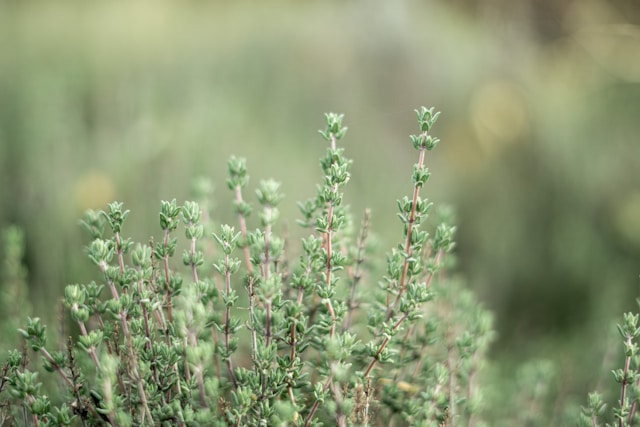Choosing the Right Thyme Variety
Thyme comes in many varieties, each with its own unique characteristics. Here are some popular options:
- Common Thyme – Classic culinary variety; grows up to 16 inches tall with white or purple flowers.
- Provencal Thyme – Strong aroma with small leaves; reaches about 12 inches tall.
- English Thyme – Milder fragrance with a soft mounded form and purple flowers.
- Creeping Thyme – Low-growing (4-6 inches), ideal for containers and ground cover.
- Golden Thyme – Features beautiful golden leaves and reaches around 6 inches tall.
- Lemon Thyme – Offers a strong citrus aroma and grows up to 12 inches tall, perfect for cooking.
When and Where to Plant Thyme
Timing is crucial for thyme growth. Here’s what you need to know:
- Starting from Seeds – Sow seeds indoors 8-10 weeks before the last frost date. Lightly press the seeds into the soil without burying them too deep.
- Ideal Temperature – Thyme germinates best at 70°F (21°C). Using a heat mat can improve success rates when starting indoors.
- Transplanting Outdoors – Move seedlings outside 2-3 weeks before the last expected frost, ensuring soil temperatures have warmed up.
- Spacing – Keep plants 6-12 inches apart to allow proper air circulation and growth.
For gardeners in hot climates like Arizona, thyme appreciates afternoon shade during peak summer months.
How to Care for Thyme Plants
Sunlight Requirements
Thyme thrives in full sun and requires at least 6 hours of direct sunlight daily.
Soil Preparation
- Thyme prefers well-draining soil with a pH between 6.0 and 8.0.
- If your garden has heavy clay soil, consider planting thyme in raised beds or containers with a light potting mix.
Watering Tips
- Water deeply only when the soil is completely dry.
- Avoid overwatering, as thyme is drought-tolerant and susceptible to root rot.
- If grown in containers, water whenever the top inch of soil feels dry to the touch.
Fertilizing
- Thyme requires minimal fertilization.
- If the soil is poor, add organic compost or a balanced organic fertilizer in spring.
- Avoid excessive fertilization, as it can weaken thyme’s essential oils and flavor.
Mulching
- Use a light mulch, such as straw or wood chips, to suppress weeds and retain moisture.
- Avoid thick layers that trap too much moisture and lead to rot.
Pruning and Maintenance
- Trim thyme regularly to encourage bushy growth and prevent flowering.
- If you prefer flowers for pollinators, let a few plants bloom while maintaining others for cooking.
- In late spring, prune dead stems to stimulate new growth.
- Divide thyme plants every few years to maintain their vigor.
Harvesting Thyme
- Harvest thyme once plants are well-established (6-8 weeks after transplanting).
- Use sharp scissors to snip off leafy stems, avoiding woody parts.
- For the best flavor, harvest just before the plant flowers.
- Frequent harvesting encourages continued growth and prevents the plant from becoming too woody.
Storing and Using Thyme
Thyme is most flavorful when used fresh, but you can also store it for later use:
- Refrigeration – Store fresh thyme in an airtight container for up to two weeks.
- Drying – Hang thyme sprigs upside down in a dry, ventilated space. Once dry, strip the leaves and store them in an airtight jar.
- Freezing – Chop thyme leaves and freeze them in ice cube trays with water or olive oil for easy use in cooking.
Bonus Tips for Growing Thyme in Hot Climates
- Plant thyme from October to April in warm regions like Arizona to avoid extreme heat stress.
- Give plants a good pruning in early spring to encourage fresh growth.
- Provide shade during the hottest summer months to prevent dehydration.
Growing thyme is a rewarding experience for any gardener. With minimal care, this hardy herb provides fresh, aromatic leaves year-round. Whether you grow thyme in your backyard, a raised bed, or a container, following these simple steps will ensure a thriving plant. Happy gardening!
If you found this guide on how to grow thyme helpful, be sure to share it with fellow gardening enthusiasts!
